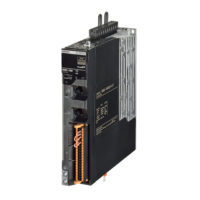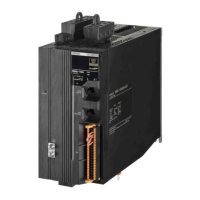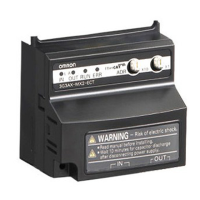
Do you have a question about the Omron R88D-1SN ECT Series and is the answer not in the manual?
| Feedback | Incremental encoder, Absolute encoder |
|---|---|
| Position Control | Yes |
| Speed Control | Yes |
| Torque Control | Yes |
| Communication Interface | EtherCAT |
| Power Supply Voltage | 200 to 240 VAC |
| Output Power | 0.1 to 1.5 kW |
| Input Voltage Range | 170 to 264 VAC |
| Control Method | Sine-wave PWM control |
| Main Circuit Power Supply | 200-240 VAC |
| Applicable Motor Capacity | 0.1 to 1.5 kW |
| Protection Functions | Overcurrent, Overvoltage, Undervoltage, Overheating, Encoder Error |
| Ambient Operating Temperature | 0 to 55°C |
| Vibration Resistance | 4.9 m/s² (10 to 55 Hz) |
| Shock Resistance | 98 m/s2 |
| Weight | Varies by model |
Describes the target personnel for this manual, requiring electrical knowledge.
Contains information necessary for correct usage and understanding of the Servo Drives and peripheral equipment.
Explains the page structure and symbol icons used throughout the manual.
Details what to do and not to do for safe product usage.
Details what to do and not to do for proper operation and performance.
Provides extra information for better understanding and easier operation.
Details specifications and functionality differences for different unit and Sysmac Studio versions.
Explains the features of the Servo Drive and names of parts.
Explains models and provides external and mounting dimensions.
Provides general, connector, and I/O specifications.
Explains installation conditions and wiring methods.
Explains EtherCAT communications and related settings.
Explains the outline and settings of basic control functions.
Provides the outline and settings of applied functions.
Provides the outline of safety functions and examples.
Explains servo parameters in detail.
Provides operational procedures for each mode.
Explains functions, setting methods, and adjustment notes.
Explains items to check for problems and troubleshooting.
Explains maintenance and inspection procedures.
Provides additional explanations for profiles, objects, and error codes.
Explains the features of the Servo Drive and name of each part.
Explains the models and provides external dimensions.
Provides general, connector, and I/O specifications.
Explains installation conditions and wiring methods.
Explains EtherCAT communications and related settings.
Explains the outline and settings of basic control functions.
Provides the outline and settings of applied functions.
Provides the outline of safety functions and examples.
Explains servo parameters in detail.
Provides operational procedures for each mode.
Explains functions, setting methods, and adjustment notes.
Explains items to check for problems and troubleshooting.
Explains maintenance and inspection procedures.
Provides additional explanations for profiles, objects, and error codes.
General overview and purpose of the manual.
Details the organization and layout of the manual.
Explains how the manual is configured and its sections.
Lists and briefly describes each section of the manual.
Outlines the legal terms and conditions for using the product.
Details critical safety information and warnings for product use.
Lists essential checks to perform after unpacking the product.
References other OMRON manuals that provide related information.
Defines key terms and abbreviations used throughout the manual.
Lists the changes made in each revision of the manual.
Explains the features of the Servo Drive and name of each part.
Details product models and their external dimensions.
Provides detailed specifications for Servo Drives, Servomotors, decelerators, and accessories.
Covers installation conditions, wiring methods, and EMC directives.
Explains EtherCAT communications, including settings and protocols.
Details the fundamental control functions and methods.
Explains additional functions such as gain switching and backlash compensation.
Details safety functions like Safe Torque OFF (STO).
Provides a comprehensive explanation of servo parameters.
Explains the operational procedures and how to operate in each mode.
Covers functions, setting methods, and notes for adjustments.
Lists items to check for problems and provides troubleshooting guidance.
Explains maintenance and inspection procedures for components.
Contains supplementary information, including CiA 402 Drive Profile and CoE Objects.
Explains the basic features of the 1S-series Servo Drives with EtherCAT communications.
Shows the system configuration for a 1S-series Servo Drive with EtherCAT Communications.
Describes the names and functions of Servo Drive parts.
Shows the block diagram of a 1S-series Servo Drive with Built-in EtherCAT Communications.
Describes the applicable standards for the 1S-series Servomotors and Servo Drives.
Explains the use of unit versions for managing differences in supported functions.
Explains the procedures to operate a system incorporating 1S-series Servo Drives.
Shows the Servo system configuration that consists of Controllers, Servo Drives, Servomotors, Decelerators, and other devices.
Describes how to read and understand the model numbers of Servo Drives, Servomotors, and Decelerators.
Lists the models of Servo Drives, Servomotors, Decelerators, cables, connectors, peripheral devices, etc. in the tables.
Provides the external dimensions and mounting dimensions of Servo Drives, Servomotors, Decelerators, and peripheral devices.
Provides general specifications, characteristics, connector specifications, and I/O circuits of the Servo Drives.
Provides general specifications, characteristics, and encoder specifications of the Servomotors.
Provides the specifications of the Decelerator models.
Describes the specifications of the cables to connect between Servo Drives and Servomotors, and the connectors to be used.
Provides the specifications of the External Regeneration Resistors and External Regeneration Resistance Units.
Describes the specifications of the External Dynamic Brake Resistor.
Describes the specifications of Reactors.
Describes the specifications of Footprint-type Noise Filters.
Explains the conditions for installing Servo Drives, Servomotors, Decelerators, and noise filters.
Provides examples of connection with peripheral equipment and wiring such as connection of the main circuit and Servomotor.
Explains the wiring conditions for 1S-series Servo Drives to conform to EMC Directives.
Explains how the Servo Drives absorb regenerative energy during motor deceleration.
Explains precautions for adjustment and dynamic brake for use within applicable load inertia.
Shows the machine accuracy (Total Indicator Reading) for the output shaft and mounting parts of the Servomotor.
Explains the indicators and switches located on the front of the Servo Drive.
Explains the structure of the CAN application protocol over EtherCAT for 1S-series Servo Drives.
Explains the EtherCAT State Machine (ESM) of the EtherCAT slave.
Explains the process data objects (PDOs) used for real-time data transfer during cyclic communications.
Explains Service Data Objects (SDOs) used for setting objects and monitoring Servo Drive status.
Explains the synchronization modes and communications cycles supported by 1S-series Servo Drives.
Explains emergency messages sent to the master through SDO communications.
Describes the features provided by the Servo Drive when combined with Machine Automation Controller or Sysmac Studio.
Explains configuring a ring topology for continuous communications even if a link is disconnected.
Explains the implemented control functions.
Provides block diagrams for position control, velocity control, and torque control.
Explains the configuration of the Cyclic synchronous position mode.
Explains the configuration of the Cyclic synchronous velocity mode.
Explains the configuration of the Cyclic synchronous torque mode.
Explains the configuration of the Profile position mode.
Explains the configuration of the Profile velocity mode.
Explains the homing operation and procedures.
Describes the settings required to connect the Servo Drive with an OMRON controller.
Explains the general-purpose input signals that can be allocated to the Control I/O Connector.
Explains the general-purpose output signals that can be allocated to the Control I/O Connector.
Explains how to prevent motor rotation outside movement range using limit inputs.
Notifies if the present position exceeded the specified movement range and stops the Servomotor rotation.
Compensates the specified backlash compensation amount, travel distance, and present position.
Sets the output timing for the Brake Interlock Output (BKIR) signal.
Controls position by multiplying position command with specified gear ratio.
Switches the torque limit according to operation direction and input commands.
Performs auto acceleration and deceleration when step-type velocity commands are input.
Switches position control gain, velocity control gain, and torque command filter.
Latches actual position and time stamp at the rising edge of an external latch input or encoder phase-Z signal.
Outputs position information from the encoder in the form of two-phase pulses.
Describes the dynamic brake operation and conditions for application.
Corrects the next target position based on the previous target position when a communications error occurs.
Used to cut off motor current and stop the motor via signals from a safety controller.
Explains how to use the STO function via safety input signals.
Explains how to use the STO function via EtherCAT communications.
Explains the format used to describe objects and their attributes.
Explains common control objects for Servo Drives.
Explains objects that set operations in one-degree-of-freedom and two-degree-of-freedom controls.
Explains objects related to the control loop.
Explains objects used for torque output settings.
Explains objects used for the homing setting.
Explains objects related to the applied functions.
Explains objects used for error and warning settings.
Explains objects used for monitoring settings.
Explains objects related to the display setting.
Explains objects used for the power device setting.
Explains objects used for external device-related setting.
Explains objects used for the encoder setting.
Explains the operational procedure for checking Servomotor and Servo Drive operation.
Explains the procedure to prepare the system for operation after installation and wiring.
Explains how to perform a test run to confirm servo system operation.
Explains the functions, setting methods, and items to note regarding adjustments.
Adjusts gain automatically based on controller commands or operation conditions.
Uses simulation to adjust gain and filter settings for fine tuning.
Adjusts multiple gain parameters according to set values for machine rigidity.
Takes samples of commands and operation data at intervals and displays results.
Measures frequency characteristics of velocity closed loop.
Reduces vibration generated by mechanical units.
Estimates machine load characteristics and sets inertia ratio, viscous friction, etc.
Reduces resonance frequency vibration by estimating it and setting the notch filter frequency.
Reduces resonance frequency component to reduce vibration and noise.
Sets three types of friction torque compensations to reduce mechanical friction.
Improves following performance for target position and velocity.
Explains preliminary checks to determine the cause of a problem.
Details warning signals for states like overload.
Lists error numbers, names, causes, and measures.
Describes events other than errors that notify of status.
Provides guidance on identifying error causes and taking measures.
Explains maintenance depending on application conditions.
Details the expected lifetime of Servo Drive components.
Lists the lifetimes for different motor parts.
Describes inspection and replacement procedures for a broken EtherCAT ring.
Describes the profile used to control the Servo Drive.
Explains the CoE objects implemented in 1S-series Servo Drives.
Lists all objects described in the manual.
Lists and describes error event codes found in Sysmac Studio.
Provides input and output response times for EtherCAT process data communications.
Describes the relationship between unit versions and Sysmac Studio versions.











